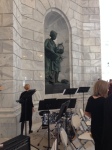
By: Kristie Hinckley
Zoltán Kodály (1882–1967) was a Hungarian who became famous for his music education program known as “The Kodály Method.” I served my mission in Hungary and as a pre-elementary school teacher with desire to incorporate music in my classroom, I had the desire to learn more about this figure who had a great impact on music education. After doing some research, I learned about this method, “The Kodály Method”. Although Kodály did not teach these techniques, nor create a step-by-step process for teachers, he did formulate the principles of this teaching practice and his followers developed his principles into the powerful method that has impacted children across the globe.
The Kodály Method uses a child-developmental approach to sequence, introducing skills in accordance with the capabilities of the child. New concepts are introduced, beginning with the easiest, and become progressively more difficult. Concepts are constantly reviewed and reinforced through games, movement, exercises, and songs.
Kodály believed that music education should begin at the earliest possible age. In his method, not only do students learn through song and movement, but they learn solfege (Do-Re-Mi-Fa-So-La-Ti-Do), hand signs, rhythm sequence, and more. I watched a short but fascinating Hungarian documentary about a small elementary school class in Hungary in the 1960s where this method was practiced. At one point the class was reading a poem. The teacher asked a child to come to the chalkboard and place five musical notes on the staff. The young boy placed the notes on the board and said each coordinating solfege name. Each student put the same notes on their small chalkboards at their desks. The teacher led the class in singing each line of the poem with this new little tune. I bet the students memorized the poem quickly and remembered it for longer because music was incorporated.
In 1945 the Hungarian government finally started implementing Kodály’s teaching strategies into public schools. The first primary school where music was taught daily opened in 1950. Over the next 15 years, roughly half the schools in Hungary were music schools. Today, Kodály-based methods are used worldwide.
Music has had a powerful influence in my life. My mom told me that when I was a child and heard a new song, I asked her to sing it to me over and over again until I had it memorized. In third grade we learned multiplication facts through song and I still remember them! I find it fascinating to learn about Zoltán Kodály and his principles of teaching that revolutionized Hungary and eventually the world.
What kind of impact has music had in your life? Do you plan on using music in your classroom? …in what ways?







